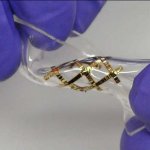
News • Future lifesavers
Tiny robots are next step to precisely targeted drug delivery
A Stanford mechanical engineer creates multifunctional wireless robots to maximize health outcomes and minimize invasiveness of procedures.

A Stanford mechanical engineer creates multifunctional wireless robots to maximize health outcomes and minimize invasiveness of procedures.

To date, there are no effective antidotes against most virus infections. An interdisciplinary research team at the Technical University of Munich (TUM) has now developed a new approach: they engulf and neutralize viruses with nano-capsules tailored from genetic material using the DNA origami method. The strategy has already been tested against hepatitis and adeno-associated viruses in cell…

Scientists have developed minute flexible robots that could help revolutionise drug delivery in the future. These ‘microrobots’ are so small that they could be ingested, or inserted into human veins to deliver drug therapies directly to diseased body areas.

Stretchable electronics is emerging as a promising new technology for next-generation wearable devices, according to a review published in Science and Technology of Advanced Materials. The technology has many possible applications for healthcare, energy and the military. But there are several challenges involved in finding suitable materials and manufacturing methods. The biggest challenge for…

An international team working at the Department of Energy's Lawrence Berkeley National Laboratory (Berkeley Lab) has captured the first high-resolution 3-D images from individual double-helix DNA segments attached at either end to gold nanoparticles. The images detail the flexible structure of the DNA segments, which appear as nanoscale jump ropes.